VIAC Review 2023 – Is the VIAC 3rd pillar any good?
This page is also available in:
Deutsch
Overall Rating
4.8 ⭐⭐⭐⭐⭐ · 🏆 Market Leader ·
At Investing Hero, we aim to provide the best investing basics. To support this, some of the products featured in articles will generate an affiliate commission which helps pay to run this website. However, this doesn’t influence our evaluations. Our opinions are our own. The information provided on Investing Hero is for informational purposes only. Please read our disclaimer.
Headquartered in Basel and founded in 2017 by Daniel Peter, Christian Mathis and Dr. Jonas Gusset, VIAC Switzerland was born from the idea to offer a simple, cost efficient and transparent way to save for your pension. In this review we’ll discover if the VIAC 3a is worth using.
But before we get into the details, a quick primer on the third pillar in Switzerland for those that aren’t familiar. Feel free to skip this part if you know already.
🎁 Bonus: Remember to check out my pillar 3A comparison page which lists the top providers in Switzerland and all the current Investing Hero reader deals & bonuses. Enjoy!
What is a third pillar?
In Switzerland, the third pillar (aka the ‘Pilar 3A’ or ‘Säule 3a’) is part of the pension system and an optional private plan to supplement your state (aka – first pillar) and company (aka – second pillar) pension plans.
Moving money into your third pillar has several benefits, from being tax deductible to having the option to pledge against a property purchase.
Contributing toward a third pillar plan is generally regarded as a good move.
What is the pillar 3a maximum 2021?
If you already have a pension fund the maximum contribution is 6883 CHF per year, without a pension fund it’s 34,416 CHF (up to a max of 20% of your income).
However, with interest rates at historic lows, you risk pumping capital into an account you can’t touch for years, and with tax benefits aside, could result in very little return on your nest egg compared to, say, a traditional index fund.
Insurance companies offer third pillar solutions, but caution should be exercised when dealing in this area. The industry lacks transparency, contracts hide away fees into the small print, and you could easily fall into the trap of bundling life insurance into your policy. Like I did.
Do not go through a broker and overcomplicate your contract with insurance. You’ll pay a penalty to break the contract, and you’ll be overcharged on the insurance.
» Related reading: 8 Common Investing Mistakes to Avoid
OK, I’ll get off the soapbox.
How do you invest your third pillar?
Most banks offer their own branded investing options for your third pillar, however you should take care to avoid many of these due to the eye watering fees and additional charges. An example would be something such as a UBS Vitainvest fund, which have annual fees north of 1.5%. It’s too high for me.

That said, it’s worth looking through what your bank offers, however they tend to bounce around this 1-1.5% range regardless of the bank, even the better value ones from the likes of Post Finance.
What else could you do?
Services such as Swisscanto (e.g. the Swisscanto Index 45 RT, factsheet here) are a little more attractive, and while they are supported on request by most banks, the rates and fees will differ from bank to bank. Again not the perfect solution, but you have quite a range of different funds at your fingertips.
You’ll have to ask the bank, they’ll send you a form in the post which will need returning with the ISIN of the fund you want to buy. It’s an old school paperwork process, but it works.
However, once everything is factored in (e.g. transaction costs, entry & exit fees) the yearly fees could creep over 1% depending on the bank, so it’s not always the most cost effective solution.
But that said, it’s better than leaving it in a ‘vanilla’ bank account and doing nothing (or even worse, contributing to an insurance policy) for 35 years.
However, there is an alternative in this growing space challenging the mainstream.
Enter the VIAC 3a.
The VIAC 3rd pillar offers some of the most competitive rates to invest your third pillar in Switzerland. Infact, as of today, they are the cheapest way to invest and have over 16,000 clients already doing so.
The transparency on these fees is refreshing, but they are also heavily focused on streamlining the customer experience and ensure the account opening process is extremely straight forward and pain free. Which is awesome.

Despite the fancy SAS style front end and slick user interface, VIAC is backed by the Terzo Pension fund from WIR Bank based in Basel, which has some 6 billion CHF under management and is regulated by FINMA. Securites are held with Credit Suisse.
VIAC Switzerland – Pros and Cons
As you can see from the rating above and this review, VIAC is crushing it. For a third pillar option in Switzerland you can’t really go wrong – and the market is playing catchup as VIAC leads the way with rock bottom prices and a slick customer experience.
| Pros | Cons |
|
|
Opening an account with VIAC
VIAC has recently announced tablet and desktop versions of the platform, however this review will focus on the mobile app. You can visit VIAC.ch for more info.

First up, either download the app directly from the homepage, or navigate to the app store for either iOS or Android and download the VIAC mobile app. It’s a light download (under 35MB) that won’t ruin your data usage or phone storage:
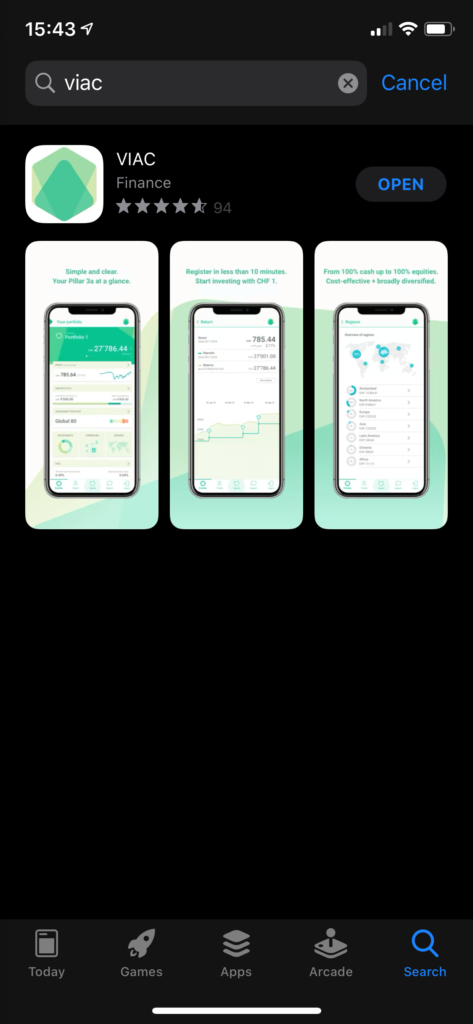
Open up the app after installing, and you are ready to get going. Tap register on the screen below:
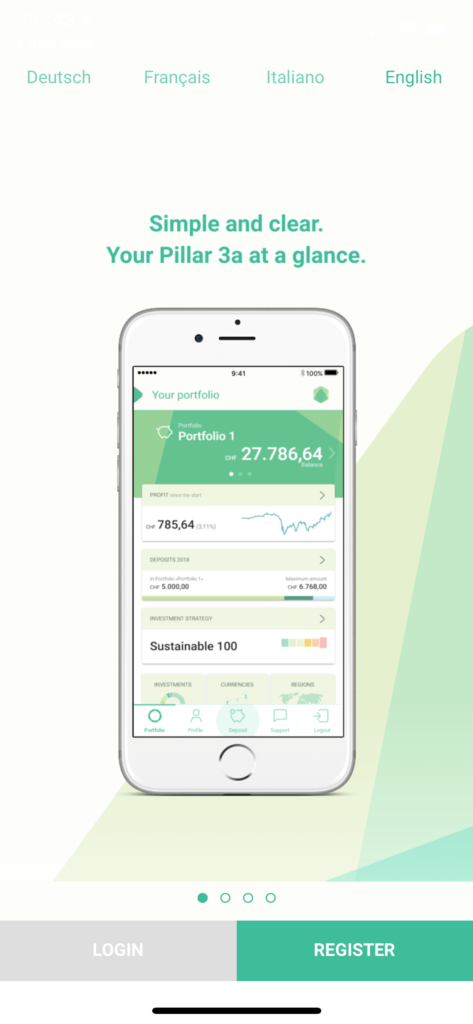
Enter your name, address and a secure password and proceed through the next 2 screens, you’ll then get the following confirmation message:
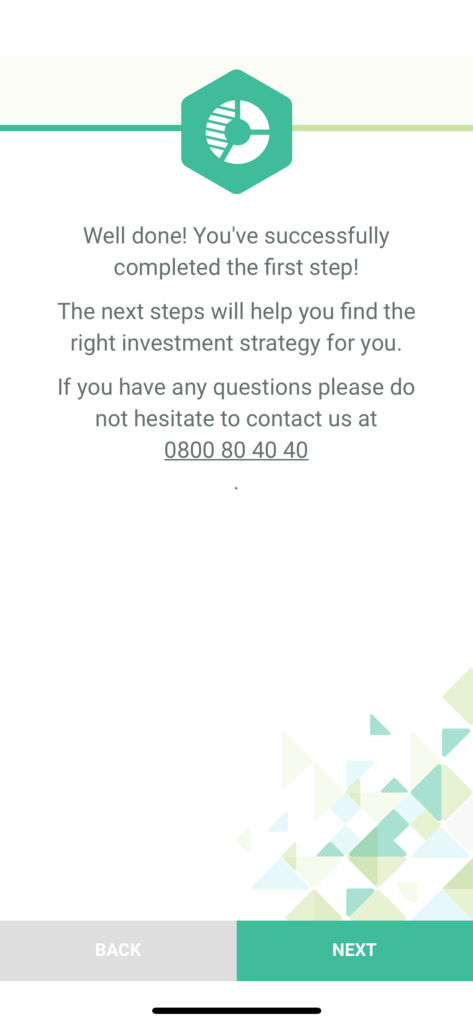
Now we move onto the defining the type of investor you are, these can be changed later but select the most relevant for you:
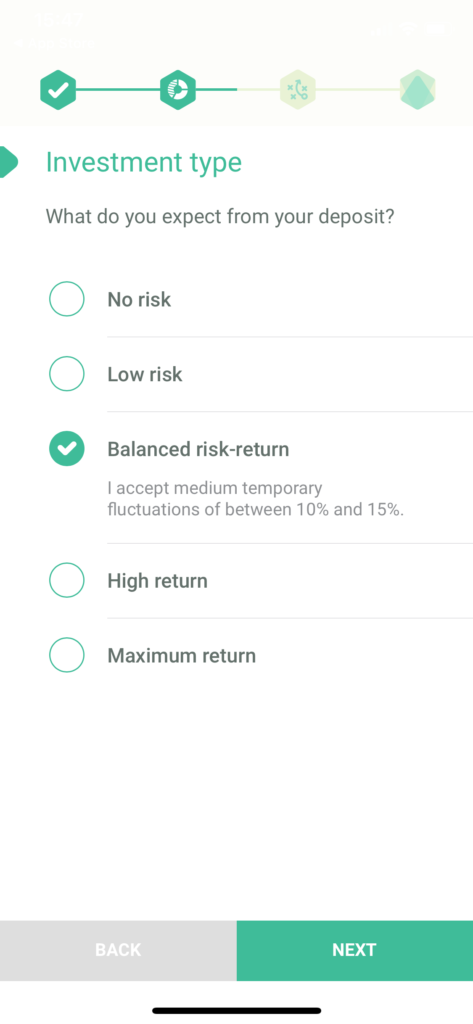
The next screen is similar, although now it shows the potential returns on your investment over the long term. You can drag the slider to adjust your risk profile:

Standard questions for financial compliance are up next – how much do you know about investing? Make your choice and tap next:
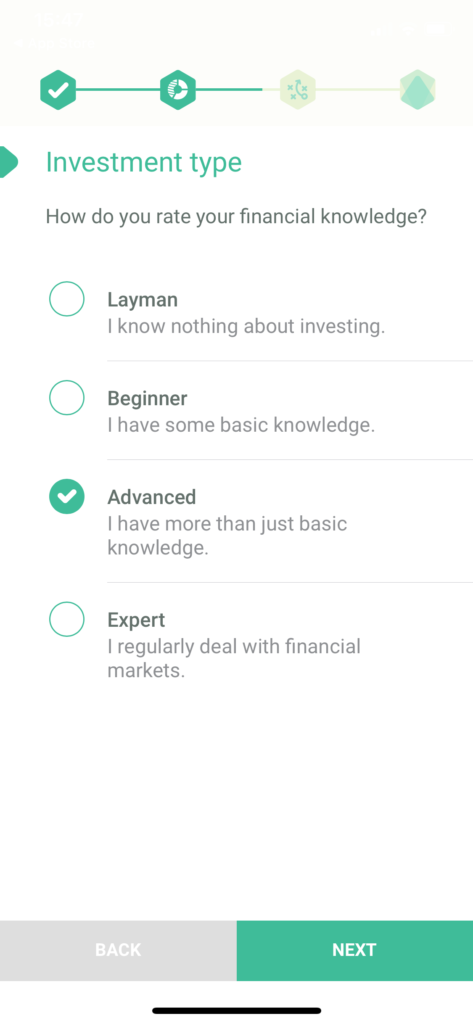
You’ll then get an assessment based on the past two choices, which gives a nice summary and the reasoning behind your profile:
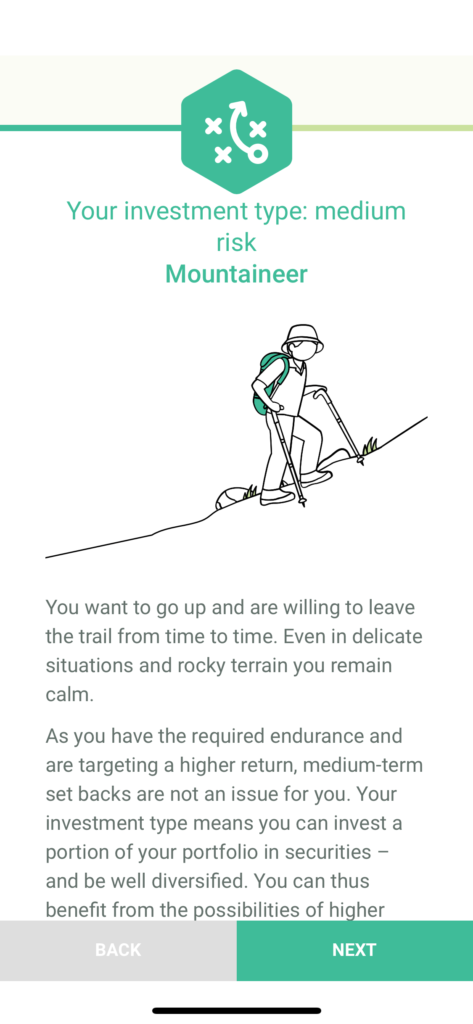
At this point you will start to shape the structure of your potential portfolio. Again all of this can be changed, but generally the global option gives you the most diversification:

And here we go- already we have a portfolio proposal and some future forecasts.
The ‘Global 80’ consists of, unsurprisingly, 80% global equities (e.g. ETF index funds). You can rotate the wheel for the other options, all the way to 100% equities should you wish.
You can also tap the ‘Details’ on the top right to read more about the investment strategy, and what will be included specifically in your future portfolio.
For this demo we’ll select Global 80 and tap ‘Select Strategy’:

Next is one of my favorite concepts about fintech today in Switzerland – disrupting decade old processes and bringing a massively optimized solution to verify users.
No more signed notary passport photos, or registered letters to post – just take a photo and you are done:

Terms and conditions up next, which you then need to electronically sign with your finger:

Congrats – you’ve opened an account. How easy was that?
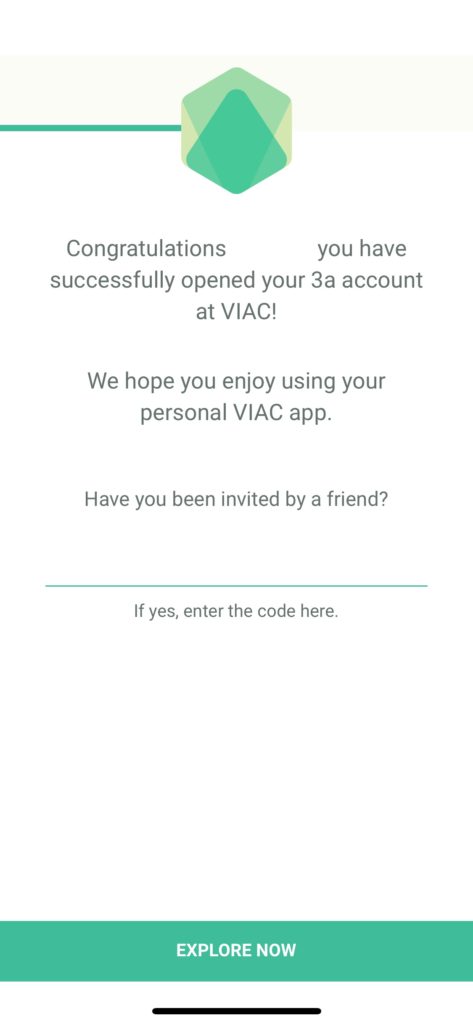
One last thing you need to do before using your account is verifying your email. To do that, tap profile, settings, and ‘Verify email’. You’ll need to enter the code waiting for you in your inbox:
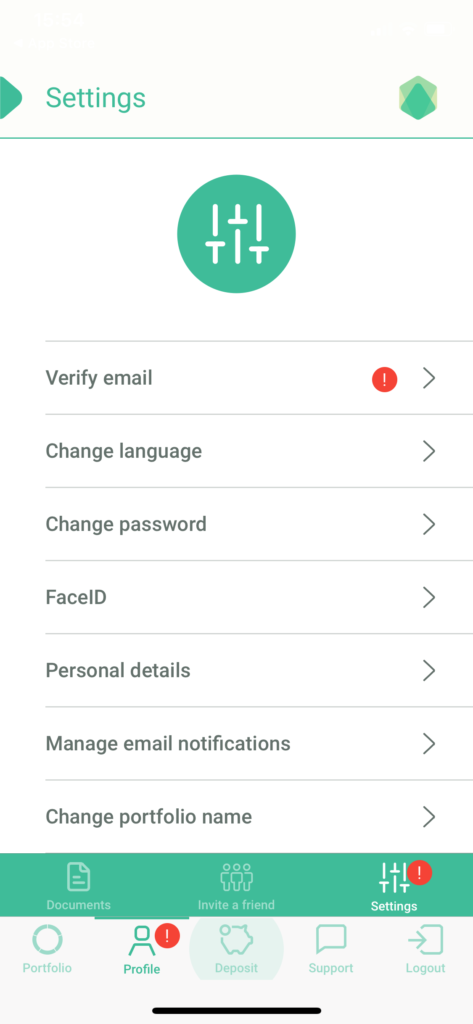
… And that’s it. Your account is open, verified and ready to be deposited with your CHF.
Funding the account
Funding the third pillar is straight forward and can be accessed directly in the app under ‘Deposit’ from any screen. From there you’ll see the bank details to make the transfer, which can also be used to setup a monthly payment – just calculate it correctly to avoid going over 6.8K.
Login & Security
As expected banking grade security is present and of a similar standard to regular online banking. You be asked to create a secure password and you can enable Face ID on iOS. SMS alerts and verification are used for large portfolio changes.
In terms of the cash and securities, they are excluded from being touched should WIR Bank or Credit Suisse go bankrupt.
Viac Fees & Charges
VIAC is transparent and upfront with the fees, which are based on the portfolio you have selected. The standard ‘non invested’ version (like a plain vanilla bank account) is completely free, you only pay when you have equities.
The more equities in the portfolio, the more you pay – but refreshingly with VIAC, the difference isn’t by much as you can see via the table below:
| Global 20 | 0.18% |
| Global 40 | 0.30% |
| Global 60 | 0.42% |
| Global 80 | 0.53% |
| Global 100 | 0.53% |
For the latest rates visit this section on VIAC website.
Customer Support
The live chat is pushed as the preferred method for support and has been very responsive with our tests and support queries. Phone and email are also available.
Additional Resources
I feel expanding the knowledge base and enabling more community interaction would be an interesting idea to explore in order to support their content marketing efforts.
Topics around the various portfolio options available, market trends and thought leadership would be interesting reading (for me anyway) with some product experts chiming in to fuel the discussion.
Reader offers & deals
VIAC are now offering free management on your pilar 3A up to the value of 5000 CHF for an entire lifetime. Due to the volume of discount codes been added to the comments, I’ve pasted them into a single Google Sheet for you to grab them:
-> https://docs.google.com/spreadsheets/d/1Yh7C-9mwuQtRn9JpgTHU4jsPYb1LacLOlJ4ew2pUt5Q/edit?usp=sharing
Enjoy 🙂
🎁 Bonus: Remember to check out my pillar 3A comparison page which lists the top providers in Switzerland and all the current Investing Hero reader deals & bonuses. Enjoy!
Closing thoughts
At the time of writing you’d be hard pressed to come up with reasons not to invest your third pillar through VIAC. Unless something considerable happens in this space the mainstream banks are still a long way off from competing with VIAC. VIAC won’t give you a sitdown meeting and free coffee however.
We could start to see more roboadvisors offering this, but for now the options are limited and VIAC remains the market leader. Until they get bought out by a cantonal bank, its a smart move for a third pillar.
2021 Update
Since this review was published there have been many other providers entering the space, including Selma and Finpension to name a few. Be sure to check out my comparison page for more details and to read about the latest reader offers and deals.
Comments are closed.



Comments: 135
Here are some working codes to get 500 CHF managed for free:
zC1Kub9
JCYRZQh
oCYR20P
BCELfWY
1Czed0s
In case anyone needs a new code (2021):
5CcftW1
OCxFNez
I share with you my codes of the day (February 2021)
WCGVzvm
RCnrU9C
Thank you for the comprehensive article! very nice. If anybody needs more codes – here you go:
KCq5xw4
BCtS0oK
eCgjwXB
fCDvMUh
1CMlalH
Awesome! Thanks for sharing.
Thank you for this interesting and comprehensive article!
Here are some working codes to get 500 CHF managed for free:
CCt5Xoa
CCOxDTf
fC08Aon
oCGTjK2
Welcome Vince & thanks for the reader codes 🙂
Thanks for the article! I just invested and I’m glad I read this.
Here are some codes for anyone seeking to get their first 500 CHF managed for free for a lifetime:
MC3hJWz
ZCLDjg5
4CyQrjH
Nice Jan, thanks for sharing!
Great Article, contains everything I wanted to know.
My codes
JCcK9UB
zCpfcmZ
Thanks for the feedback Gian and the reader discount codes!
Thank you for this article!
In case previous discount codes are no longer working, mine are
pCtcwT7
SCLFp1y
uCQFzSe
Thanks for sharing Javier!
Thank you!
“Fresh” codes to profit:
cC9e3Te
DCjEnuK
pCTvyVS
Have fun!
Danke für die vorhergehenden Codes 🙂
Hier noch aktuelle:
EC8VHEi
ECtp24B
fCeX578
Cheers
Here you go, another “fresh” code:
XC4EI8h
Here are 3 more codes in case the last ones are outdated :
mCI48q1
1CJWteh
Hi everyone, here are some more codes in case you already haven’t signed up. Highly recommended!
SCMoiN2
eDChJD
Regards
Neue Codes vom 03.06.2020->
Verwende bei der Registrierung folgenden Code:
HCjRYuJ
PCoYXXu
8CUxUM8
Wow, ich hätte das nicht gedacht. ETFs statt Aktien Fonds. Das nenne ich die modernste Art von Vorsorge in die Säule 3a, die auch wirklich Sinn macht. Vielen Dank für deine beratetenden Worte über viac.ch
Ganz neu: Verwende bei der Registrierung folgenden Code:
QC4LcNP oder 9Cygmj7
Dann erhällst Du auf den ersten CHF 500.00 Vorsorgevermögen keine Verwaltungsgebühr – ein Leben lang!
Hi everyone, here are some more codes in case you already haven’t signed up. Highly recommended!
qCvodmm
uCxUljm
gCJRKSo
uCevkk2
Here is one code I generated today:
xCm2lwu
4 more codes generated today:
-KCX2rAR
-ACRRHuo
-3CRWi4l
-gCPEOg4
Oh wow My codes were actually used by 2 people. Who would have tough …
Here are 2 more just in case some one needs it:
cCrFKIy
2C49wkj
Thank you for the review and the codes ! I used one from above ! Great stuff:
Here are some generated today:
GCQdzpm
0CVNpX5
eCdMvXn
Some working codes in case anyone is interested:
MCJQDKE
LCThbWd
iC3NGT1
Hi there,
good review. I just opened my VIAC account – like the flexibility and low fees.
You take some, you give some – here are three codes, freshly minted:
zC1pW1o
QCo8jQ4
4C0DvTB
Cheers,
J
Hi everyone, here is a fresh referral code: rCLMrdh
Feel free to use this referral code to get 500 CHF managed for free:
JCIMNKI
GCNrriv
TC9Op2y
Feel free to use this referral code to get 500 CHF managed for free:
VCfMkys
Fresh codes!
jCZ8JWm
XCIieHG
VCBNuVl
Hey – great review!
Feel free to use the following referral codes:
dCaEWuV
zCiIZ2J
7CfmGUY
UCI2ddb
oCQdoIN
Neue Codes
9CCfaAr
sCKAOvY
kCJhoyM
7Cmhxr2
DCyWbKo
Thank you for the review!
If you are looking for referral codes:
cCQy3n4
gCEuDmJ
Hello,
I have a doubt regarding VIAC or UBS. I have 3a in UBS without been invested in any funds and I would like to put in a funds. I was going to transfer my 3a pillar money from UBS to VIAC but UBS worker told me that there is no commission in you have a 3 pillar in UBS and put the money in Vivainvest fund. Please, read below the conversation I had with the UBS worker:
Hello Jesus,
Yes there is indeed fees related to the vitainvest fund but it is supported by UBS.
The client does not pay any fees/charges related to funds invested through 3rd pillar.
The fees apply for regular fund (outside of the 3rd pillar).
I hope this answer your question and I remain at your disposal for any other information.
Have a nice afternoon
Best regards
UBS Switzerland AG
Agence de Neuchâtel
Conseiller Clientèle
Anthony Ribeiro
—— Message original ——
Hi Anthony
I found fee in Vivainvest https://www.ubs.com/2/e/files/RET/FS_RET_CH0293174600_CH_EN.pdf
management fee 1,28% and ongoing charges 1,67%.
Please, can you check it. You informed me that invest my 3rd pillar in vivainves doesn´t have any fee but the brochure says yes.
Thansk
Jesus
Is it correct the info he gave me?
Thanks for your help,
Jesús Sanchez
Feel free to use the following referral codes:
6CpdkmJ
TCyaZ1h
OCmbASg
4CsnwSb
Hi, thanks for the helpful article!
Feel free to use my codes for an easier start:
qCqCBvs
RCIsc9a
gCNZ2gW
@Jesús Sanchez – Are UBS saying the fund is free in that case? 😀 No commissions, no custody, no entry/exit, no conversion fees… lol yeah right.
Hello, I would like to share my codes too:
LCKihAO
UCbBtjT
9CwwkrH
Hi, thanks for the very helpful article.
Here are some fresh codes if someone is interested:
nCaDouI
wC043sV
gCzfhuF
Here are some new codes:
bCms6n9
8CbvPuu
yCmWzNC
gCX01Eg
Each code is new worth up to 1500.- CHF of assets managed for free!
I recently opened my VIAC account and I’m very satisfied. Here are my codes to get 500 CHF managed for free:
1Cf97H8
TCWI2yj
qC0mj1f
I have Viac since 1 year and I can only recommend it. i have 3 accounts. global 60 where i transferred the money from a previous bank account, and 2 young accounts global 80 and swiss 80. overall about 4% plus this year. not bad, considering covid!
some codes below, as the referral program has just been improved, increasing the tax free amount from 2000 to 5500 chf!
nCDatkB
BCY6Eih
PC0tV2w
RC0jvAz
bCSIPO1
KCoeWJN
0C7iESr
CCYfrqt
Fresh codes for you all.
VIAC changed to get up to 5K managed for free:
8CzffBY
LCdfczw
Some new codes:
QCW0QYc
qCNej7o
sCUUUO6e
8CLvVq1
KCTfjfQ
Good article. I’m absolutely satisfied with Viac and recommend it to everyone.
Codes to get 500 CHF managed for free
uCusmun
ICqjucw
Cheers
Here are some working codes (as of 13.11.20) to get your first 500CHF managed for free:
2C5Y8oi
TCxb2rH
BC7wcxE
zCA8XtO
gC13kPL
hey all… quick question… how does one apply these codes ? only whenever money has hit/been deposited into the viac account ?
Hi all,
How do these codes work?? Only during initial viac signup?? I created viac account last year before finding investinghero.ch.
Cheers
freshly generated code (16. November 2020): PCOtHus
These codes were freshly baked this morning-16.11. Enjoy your first 500 CHF managed for free!!!
lCf9gzu
pCnm1K
pCnm1KA
UC6fAWu
Some new codes her:
BCvl5gD
uCYtrgt
ACYC3JS
YC2RhyN
Thanks for the article! I’m also very happy with VIAC 3a so far.
Here are some more codes for people to use:
VCQam81
aC9bhvr
vCXN465
QCC9V5E
Cheers!
Great article! Very happy with VIAC 3a! Here a few codes, for others to enjoy as well:
ECIR7fB
oCSiJzl
SChkqgX
HCerO14
cCbwrrY
Hallo!
Dank dieser Empfehlung bezahlst du auf den ersten CHF 500.00 Vorsorgevermögen keine Verwaltungsgebühr – ein Leben lang! 🙌
Verwende bei der Registrierung einer folgenden Codes:
rCgPXeC
ACGB2uh
wC4I4HX
4CSiG7U
Viel Spass beim Sparen!!
Gruss
Simone
Hi all,
here are new codes:
hCOyars
dCzIu6c
yCxMUcD
Regards,
Klaus
Hier sind weitere Codes für euch
zCS9knZ
mCvYHz0
GCNeMaL
zCnSwHf
4CJH13K
VIAC was absolutely the right choice. If you also want to move your 3rd pillar to VIAC you can use one of these codes to get your first 500CHF managed for free.
0CUDwzI
sCJ90bP
RCdVxwu
…und noch ein paar neue Codes:
mCVqRW5
hCSuBdS
jCVeDC1
gCib4wl
JCZNuQH
Thanks for this great article, it convinced me to switch!
Here are a few fresh codes for those who need one:
zCAVBhY
GCxgDHu
mCHrgkB
OCCKk3Z
5CILgz2
Use the code and get your first CHF 5000 managed free with VIAC. Last three left only
zCiX2Ub
8CTQMGl
tCzo6fd
Thanks for this wonderful article Mr IH.
get FREE maintenance of your first CHF 500 with codes below:
YCurxpz
4CAejd0
MCn4uNj
UC4WEFG
MCakA5G
Thank you and enjoy your CHF 500 freely maintained with VIAC
Referral codes for administration fee waiver; get your first 500 CHF managed for free for your entire lifetime 🙂
sCQqFLd
kC8gfNo
sCidN4r
NCBP1rY
pCwKzyo
Thanks,
David
Thank you David for sharing.
Thank you so much for sharing this article, really helpful.
Some very fresh codes to save fees on your first 500chf with VIAC (only these two left)
jCxYt6N
RCpM2pP
Thank you!
Great, thanks Fernando!
I just joined VIAC thanks to your review!
Here a some new codes for other joiners (no fees for first 500 CHF invested):
7CYICQN
BCLoykl
7C6cUJE
5Cgm6wr
Thanks for sharing Alexandra!
Thanks for the article!
Paying it forward with the referral codes:
dCw8U0K
LCwDUUV
WCOQQJ6
iCW5hkM
ACDAz7j
Cheers,
Daniel
Welcome & thanks for sharing!
Referral codes for administration fee waiver; get your first 500 CHF managed for free for your entire lifetime 🙂
KCAFcEM
LCpCqFn
9CT2krq
mCgyQB4
yCETQqX
Thanks,
Mirriam
Thanks for your review! I just joined VIAC and got a code through the comments above. 🙂 Here a some new codes for other joiners (no fees for first 500 CHF invested):
iCkzrJI
HCBAUUJ
qCQV5jn
Thanks for the article! I’m also very happy with VIAC 3a so far.
Here is my last code to get your first 500 CHF managed for free for lifetime.
ZCBH57f
Thank you
Hi,
thx a lot for the review and thx for sharing the codes, too!
Here are new codes:
oCzsK3t
NC3fAPZ
hCH1GKx
QCqdJo6
rCViV07
Regards,
Klaus
Great article and review! Used a code from above and sharing mine if anyone wants to use and get their first 500CHF managed for free with viac.ch
UC40zET
nCxpFpM
Thank you
Thanks for the article!
Here are some codes for new joiners (no admin costs for first 500 CHF):
qCrFxW6
NCD8hkH
kChdQ9u
gCzVmfv
Thanks for the review, I’ve just signed up for VIAC in no small part because of this. 🙂
Also thanks everyone for your codes!
I would also like to share mine if you don’t mind, since it’s a win-win situation. Get rid of the administrative fees on your first CHF 500 for life. If one of the codes is already used, try the next one.
Don’t be alarmed when you can’t enter the code right at the beginning of the registration: The code can be entered towards the end of the initial sign-up process.
DC1VS7c
ZCjKCWZ
ZCIMSuF
ZCKOLyQ
mCbxzPF
And here are the codes of my SO 🙂
wC51XdZ
JCjHXBK
lCdAzdi
jCX8hPZ
Cheers and happy saving/investing!
LM
Great article, and thanks for the codes.
Here are some fresh ones 🙂
0C2CCMj
sCGuNvC
fCDkeRC
CCr4AfU
XCxuCli
Thank you for the article.
Find below referral codes (no fees for first 500 CHF invested):
4CGRqpF
rCGMNFk
LCrBWxg
vCFkSFR
Paying it forward also with the referral codes 🙂
wCZJZK6
3CAvWA6
6C0brHZ
0C2p5nh
Thanks a lot for the article
Here a some new codes for other joiners (no fees for first 500 CHF invested):
BC6i0dC
QCdyTSh
fCSkhs1
ICmoLNZ
6C5LABI
Best regards,
Ismael
Thanks for this great article!
Here are two of my referall codes to save the management fees on the first 500chf
LCAwGxx
UCJZ2al
Thank you!
Hi,
Thanks for the review and also for sharing the codes!
Paying it forward with 2 new codes:
1CFzubY
0C0AM9g
Regards,
Daniel
Hi
Thanks for the review.
Here are new codes:
dCfE8JG
pCY0EyP
nC2GlBn
fCNZ5jf
UCIOLLc
Regards
Hil
Hi,
Thanks for the review and also for sharing the codes! Here are new codes:
TCHQRsX
6C8orVK
kCqzixS
tCrHlWR
Hi,
Thanks for this great article.
Below are 4 new codes:
nCTm2lj
qCkzxMX
jCzhRBz
bCqUDMN
Regards,
Greg
Thank you very much for this helpful article. Please find below some more working VIAC codes so we can save together. Happy end of year holidays!
jC9f22g
8CYlT9i
9CBrvTQ
hCxO4no
Hello everybody and thanks Mr.IH,
Here are codes to continue the chain:
wCrLAXy
2Cqfnux
YCKRPnq
Nice review thanks. I second your review completely. Viac is by far the easiest investment platform for 3a pillar I’ve seen around.
A few more codes to get 500 CHF off:
bCJaFOH
uCUxF9N
VCrV7Wk
Thanks for the review! Some more codes:
JCUdyYc
1CSRUR5
xCphNyl
mC2PhNe
PCRSA5X
Thanks for the review.
Use the following code to register to get 500 off:
NCcTzpa
lC3RbkE
jCttjEu
qCgztck
7CNyeIt
Thanks for the article.
Here are some codes :
8CJZOAs
tCVtbtV
9CgNunA
Hello
Referral codes for administration fee waiver; get your first 500 CHF managed for free for your entire lifetime 🙂
yCy2oie
5CSkZJs
XCV9m2G
MCwrRsU
Thanks,
Chriso
Here are some of my new codes:
XCdvINX
fCoP2xY
OCVYVMe
9CF9djt
Thank you for this guide. Your tips and info was very helpful !
Great review, thank you! Here is a code to get 500 managed free:
5CU39Ct
Thanks a lot! Here 5 more codes:
TCUPqzw
oCOSxwQ
pCICHAM
CCgSllp
sCjDCjt
Hi,
again, thx a lot for the review.
2 new codes:
DCVQMhJ
lCUaoYu
Regards,
Klaus
Hey,
Here are three new codes for VIAC:
– VCcLHSq
– 8CBeWC9
– bCFJKLo
Many thanks !
I also have one more referral code for VIAC:
cCdXQ40
Apply at the end of registration to use VIAC and have the management fees offered for your first 500.- for life.
Anymore codes pls?
Thanks!
Here are 4 new codes:
sCwxnr8
kCTAEti
JCTWJuT
3C41xCG
Regards.
A fresh code!
CCH3idl
Cheers! Ale
Thanks a lot for the article
Here, my referral code to save fees on the first 500chf
FCYcrjs
QC85zks
RCaVIHz
4CoYUAD
eCZCy9e
Best regards,
Ismael
Thanks for your great advice!
Here is a referal code for VIAC: JC505hq
Thank you for the report. Viac.ch is a great solution for the 3rd pillar.
Use one of the following codes and you will get 500Fr. managed for free:
nCYVZJW
yCkHYli
HCDxlRe
Here are three referral codes for VIAC:
– LCgN2jy
– nCjWwgZ
– rCDviWl
Here are my codes:
qCMhbti
8CkGrbs
rCZynjj
9C982WU
TCN9lP5
Best
Gian
Thanks for the quality info!
These are currently valid quotes to get 500chf taxes saved:
KCOHjEl
uCmK69M
SCvu0wx
sCbKz5h
Happy savings!
Thank you for the review. I am glad I chose VIAC.
For those who still need to create a VIAC account: use one of the codes posted here to save on fees.
Here are a couple new codes:
5CrefXD
cCRnlqB
BCO49wo
Hello
Opened an account with VIAC on Monday and sent in money yesterday. New referral codes to save mamangement fees on your first 500 CHF asset below:
rCuW2nQ
JCCSEiQ
Cheers
here some new referral codes to save management fees on your first 500 CHF asset:
5CWHIVy
2CB6DuT
qCRFRA4
pCUJE4
iCxGNub
Thank you for the detail write up! Very useful. 🙂
Here’re referral codes for saving management fees on your first 500CHF:
4CnEeL2
RCyZR4d
New code 🙂
1CtOd9s
Use the following code to register:
uCO2LD7
eC5r4Be
I moved my 3a savings to VIAC a few months ago and am happy about it.
To save the management fees for your first 500 CHF use the codes:
NCewCfr
yCT7Wlf
oC4fCmG
Fresh working codes as of Feb 22, 2021:
OCfgjv1
WCzMi4k
I have new codes available:
pCBifPy
kCocUhI
fCUZiZc
NCtm4Xb
lCq82RQ
In case you need some unused VIAC referral codes:
XCcloy4
4CNqI9x
dCIFIc7
uC5tlFz
QCvWwpg
More codes to save the management fees of your first 500chf with Viac3a
hCN605Q
aCamVYl
3C0ZphZ
tCX67J8
nCZQdZN
I can also highly recommend VIAC. I opened multiple portfolios with different strategies (Global 100, individual unhedged global 100, NASDAQ-focused).
I hope the following codes can be of help for those who are considering opening an account:
JCd3Yyb
HCfmg8O
sCusqlw
pCh3NIu
5CB43cX
Hi guys!
Some more codes to profit from:
2C5V8kB
kCzVzKO
GC9V6qC
1CU71vJ
4CMhnmz
Hello
New codes for you
cCChTVG
zCa05PV
aCm3mRH
lCcJ3Go
HCMFFS9
Hi all,
one more code for you:
VCTMro2
By the way, Viac just reduced some costs, too!
Regards,
Klaus
New codes:
wCJblat
dCrsVbB
XC0eT8s
More codes to save the management fees of your first 500chf with Viac3a
iCILQsm
3CqmQ4B
2Ce5nJg
Set up ur account now, best decision ive ever made!
Fresh codes to benefit:
rCSPkK5
ACGl6At
7CfvKbt
My last code for free management of your first 500 CHF:
xCcxgM9
Due to the volume of discount codes been added to the comments, I’ve pasted them into a single Google Sheet for you to grab them:
https://docs.google.com/spreadsheets/d/1Yh7C-9mwuQtRn9JpgTHU4jsPYb1LacLOlJ4ew2pUt5Q/edit?usp=sharing
Enjoy 🙂
Thanks for creating the google sheet.
If needed, new codes:
pCXoORK
FCXCb1Y
bClppfW
Hey,
Here are three new codes for VIAC:
– FCAWzjn
– MCVW2SE
– PCd36JZ
Many thanks !
Viac fits well into a minimalist life style.
– Incredibly efficient registration (takes around 10 minutes and when using the code 5CSAYB6 in the registration process, you pay no administration fee on your first 500 CHF pension assets)
– Great customer service (fast response)
– One app, no extra mumbo-jumbo
– Can be used for tax-returns if you pay standard tax or “Quellensteuer”
Very satisfied.
Use the following code to register:
zC54Z8z
Have fun!
Here are 3 new codes for your registration at VIAC 🙂
I’m glad if you use one of these.
With this code you will invest your first 1’000 CHF for free – for a lifetime.
cqb5TFF
mdfYjVi
46TpXLy